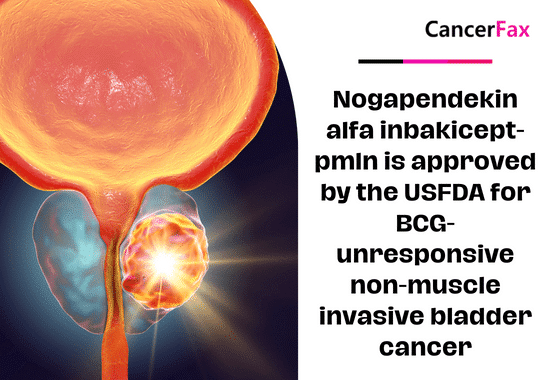Nogapendekin alfa inbakicept-pmln with BCG for bladder cancer
There is a type of bladder cancer called NMIBC that does not spread to the muscles. The Food and Drug Administration has approved the use of nogapendekin alfa inbakicept-pmln (Anktiva, Altor BioScience, LLC) and Bacillus Calmette-Guérin (BCG) to treat adults who have it. This includes carcinoma in situ (CIS) with or without papillary tumors.
Efficacy and Safety
The effectiveness of the treatment was assessed in a clinical trial called QUILT-3.032 (NCT0302285). This experiment had 77 patients with high-risk non-muscle invasive bladder cancer (NMIBC) who did not respond to Bacillus Calmette-Guérin (BCG) treatment. These patients had carcinoma in situ (CIS) with or without Ta/T1 papillary disease, and they underwent transurethral resection. Patients were administered nogapendekin alfa inbakicept-pmln by intravesical instillation with BCG as an induction therapy, followed by maintenance treatment for a maximum duration of 37 months.
The evaluation of tumor status was conducted using cystoscopy and urine cytology at 3-month intervals for a maximum duration of 2 years. Additionally, a biopsy (either random or cystoscopy-directed) was mandatory within the initial 6 months following the commencement of treatment. Following evaluation was conducted according to the norms set by the local community.
The primary metrics of effectiveness were the rate of complete reaction at any point in time and the length of time that the complete response lasted. It was known that there was CR when the cystoscopy showed no tumor. This included TURBT (transurethral resection of the bladder tumor) and biopsies, if needed, along with urine cytology.
The complete response (CR) rate was 62% with a 95% confidence interval (CI) ranging from 51% to 73%. Of the patients with CR, 58% had a duration of response (DOR) that lasted for at least 12 months, and 40% had a DOR that lasted for at least 24 months.
The predominant side effects (≥15%), encompassing abnormalities in laboratory tests, were elevated levels of creatinine, painful urination, presence of blood in urine, frequent urination, urgent need to urinate, urinary tract infection, increased levels of potassium, musculoskeletal discomfort, chills, and fever.
The suggested dosage for nogapendekin alfa inbakicept-pmln is 400 mcg, to be delivered intravesically with BCG once a week for a total of 6 weeks as part of the initial treatment. If the desired level of CR is not obtained at month 3, a second induction course may be given. The recommended maintenance dose following induction therapy is 400 mcg injected intravesically with BCG once a week for 3 weeks at months 4, 7, 10, 13, and 19, resulting in a total of 15 doses.
Patients who have a continuous complete response (CR) at month 25 or later may have maintenance instillations of BCG once a week for 3 weeks at months 25, 31, and 37. A maximum of 9 further instillations can be given. Discontinue treatment if the condition persists after the second round of treatment, if the disease returns or worsens, or if there are adverse effects that are not tolerable. The treatment might last for a maximum of 37 months.


